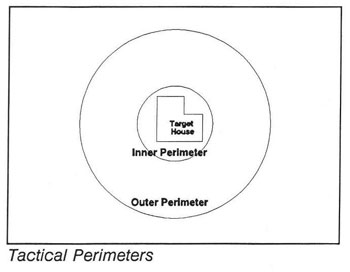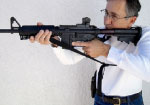 Some Tactical Teams were formed after the 1966 Texas Tower Sniper incident and the 1972 Munich Olympics massacre. Prior to that time many agencies had a group of officers that were proficient in weapons usually due to military training. They were often called upon to use those skills in high stress situations. As an example, in 1965 was the Hub Loan “shoot out” in downtown San Diego (Video clip here). Many changes in tactical operations have taken place since that time. Most teams were formed formally during the 1980’s.
Some Tactical Teams were formed after the 1966 Texas Tower Sniper incident and the 1972 Munich Olympics massacre. Prior to that time many agencies had a group of officers that were proficient in weapons usually due to military training. They were often called upon to use those skills in high stress situations. As an example, in 1965 was the Hub Loan “shoot out” in downtown San Diego (Video clip here). Many changes in tactical operations have taken place since that time. Most teams were formed formally during the 1980’s.
One of the most difficult jobs in law enforcement is the management of tactical resources during a confrontation. Whether the problem is an armed and barricaded suspect or a terrorist hostage taker, the law enforcement incident commander is faced with the same challenges - how best to deploy his or her resources to facilitate a successful resolution to the problem. Staffing levels of Tactical Teams have been discussed and debated numerous times over the years. The size of a team is an important factor and directly relates to the successful outcome of an incident.
Having observed in the CAI classes, many teams from around the state have an inadequate staffing level to carry out important functions of the unit. Most teams are significantly under staffed if required to respond to a large or drawn-out tactical situation.
How many officers do you exempt from call at a time? How many officers are away at training and/or on sick leave? Many teams are understaffed to the point that there is no relief from standby call-out status. Every law enforcement officer including tactical team members need a time away from the stresses to decompress.
There are several activities that transpire during tactical incidents. Each of these activities add to making the tactical resolution safer.
Each incident needs a perimeter established around it. That is  a group of deputies trained in keeping a suspect(s) contained. They also must deal with the suspect or hostage coming out of the contained area. Each perimeter team should have a trained grenadier as part of the team. The number of officers used for this very depending upon the size of the containment area. At a residential incident it may take from six to eight deputies to handle this function.
a group of deputies trained in keeping a suspect(s) contained. They also must deal with the suspect or hostage coming out of the contained area. Each perimeter team should have a trained grenadier as part of the team. The number of officers used for this very depending upon the size of the containment area. At a residential incident it may take from six to eight deputies to handle this function.
While these perimeter positions are being set into place, it is necessary to have counter-sniper or marksperson teams in place to cover their movements. These are teams that watch the suspect's position to ensure that he/she doesn't come out and injure the perimeter deputies. They also are an excellent means of gathering intelligence on the target. With the high optics on their rifles they can often see into building to report on the hostage taker/suspect's actions.
At the same time this containment is being set in place officers are organizing or preparing to make entry into the containment area. This is a minimum of five officers and a team leader. The number again may vary depending on the size and configuration of the containment area.
An officer should be assigned as a Hostage Negotiation Liaison. This is an officer that is with the hostage negotiators to relay instantly information to the Tactical command personnel. Another officer should be assigned to the Tactical Operations Center (TOC). The TOC is a group of investigators trying to gain knowledge of the suspect(s) and the situation. Another officer should be assigned to the patrol command that is handling the outer perimeter and traffic control. Still another officer needs to be assigned to logistics. Someone to get the tools the other officers require to do their job. Sometimes he may be called a gopher. His position is essential so that the other officers can concentrate on preparing for their mission.
An officer rescue team is another essential element that needs to be established at a tactical operation. This is a group of tactical officers that are in place to respond to injuries of fallen officers or civilians at the scene. They may also be used as a response team to back-up any other elements that may need assistance. Most agencies have separate response and officer rescue capability at a tactical operation. This should be another group of five officers and a team leader at a minimum.
In a large containment area, it may be prudent to have two entry teams to make entry at different locations. This gives the field commander, or the team leader more options and increases officer safety. This allows for more uncertainty by the suspect in identifying where entry might be made. This would be another six-person team.
 If you were to total up manpower commitments as I have described it would take twenty-eight officers excluding the team commander. This does not account for the functions that are usually left undone by the field commanders such as intelligence gathering or equipment movement.
If you were to total up manpower commitments as I have described it would take twenty-eight officers excluding the team commander. This does not account for the functions that are usually left undone by the field commanders such as intelligence gathering or equipment movement.
It also does not address relief at a long situation. Each officer is different, but as a manager I must consider rotation of personnel at a maximum of every four hours. Can I accomplish that with the manpower mentioned? Many agencies have adopted a 10% increase in manpower to accomplish incident relief, vacations, off site training, sick and injury time, and off-call time.
Many teams approach to filling the officer void is to call upon another agency to assist. When this happens, you can have a major problem with communications. Are other law enforcement agencies within your jurisdiction on a compatible radio system with you. If not, this creates a problem with instant commands and orders within critical time periods.
Do you train with the assisting agency enough to have compatible policies and procedures? A noteworthy policy to consider is the shooting policy. Although all agencies operate within the California Penal Code, terminologies and orders vary. Any confusion along these lines could be costly in human life and the financial results of litigation.
Do you have the manpower within your agency to have an adjunct team? A team of officers that can be called upon when needed to supplement the full-time team. It requires that these adjunct officers have the same training as your regular or full time team.
Another option is the formation of a county wide tactical task force. This approach will spread the cost of tactical responses to all the cities in your county or region. It would supply a larger manpower pool for all the cities in the county. The budget and manpower can be allocated by the historical use of SWAT from all the cities. The task force could be equipped with the tools that already exist within all the agencies participating. The draw back to the concept would be control of the unit. Who politically would decide on missions.





